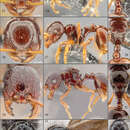en
names in breadcrumbs


No material examined.
Diagnosis of worker: TL 4.6 - 5.3 mm. Clypeus dorsally with median carina, ventrally with transverse ridge. Masticatory margin of mandible with diastema. Dorsum of head and alitrunk smooth and punctate. Pronotal spines very long (PSL1> 0.35), longer than long propodeal spines (PSL2> 0.11). First gastral tergite without setae.
Previous records from the Philippines: Negros Oriental (Cuernos de Negros, Dumaguete [type locality]) (Wang 2003).
General distribution: endemic to Philippines.
No material examined.
Diagnosis of worker: TL 3.7 - 4.2 mm. HW 0.98 - 1.04. Clypeus dorsally with indistinct median carina (only posteriorly indicated), ventrally with weak medial tubercle. Masticatory margin of mandible with diastema. Dorsum of head and alitrunk smooth, on head sparsely punctate. Pronotal spines tooth-like, propodeal spines slightly longer. Anterior face of petiolar node not separated from dorsal surface of peduncle. First gastral tergite without setae.
Previous records from the Philippines: Luzon: Ilocos Norte (Banqui = "Bauqui" [type locality]) (Wang 2003).
General distribution: endemic to Philippines.
Taxonomy. The genus Pristomyrmex is assigned to the tribe Myrmecinini together with Acanthomyrmex, Myrmecina and Perissomyrmex (Bolton 2003). The genus was recently revised by Wang (2003). Workers of Vietnamese species have the following features.
Worker monomorphic; head in full-face view rounded, or rarely subtrapezoidal (as in P. profundus); frontal lobe reduced or vestigial; frontal carina usually developed; antennal scrobe absent or indistinct, but rarely well developed (as in P. profundus); anterior clypeal margin with three or more denticles; median clypeal seta absent; lateral portion of clypeus reduced; posteromedian portion of clypeus broadly inserted between frontal lobes; antenna 11-segmented with distinct 3-segmented club; eye medium sized; masticatory margin of mandible almost vertical to basal margin, 3-, 4- or 5-toothed; mesosoma short and high; promesonotum not domed, but rarely raised above anterodorsal border of propodeum (as in P. profundus), unarmed or armed with a pair of humeral teeth or spines; promesonotal suture absent dorsally; anterior part of mesopleuron forming a flange projecting over basal part of fore coxa; metanotal groove usually absent, but rarely marked weakly (as in P. profundus); propodeum armed with a pair of teeth or spines; propodeal lobe triangular, blunt-triangular, or semicircular, but rarely absent (as in P. profundus); petiole with peduncle and node; postpetiole relatively short and high.
The worker of Pristomyrmex is similar to the minor worker of Acanthomyrmex (for distinguishing characters see under Acanthomyrmex ).
Vietnamese species. Five species have been recognized by us from Vietnam: profundus Wang [= sp. eg-4] (Phu Quoc); punctatus (F. Smith) [= sp. eg-1] (Ba Be, Pu Mat, Tam Dao); rigidus Wang [= sp. eg-2; = sp. 20 of SKY: Eguchi et al. 2005] (Ba Vi, Tay Yen Tu, Van Ban); sulcatus Emery [= sp. eg-5; = sp. 13 of SKY: Eguchi et al. 2005] (Ba Vi, Cuc Phuong, Phu Quoc, Pu Mat, Tay Yen Tu, Van Ban); sp. eg-3 [cf. occultus Wang; = sp. 16 of SKY: Eguchi et al. 2005] (Tam Dao).
Bionomics. The thelytokous Pristomyrmex punctatus is nomadic, but the other Vietnamese species live in rather stable nests in rotting twigs and wood fragments and under stones. The colony size of Vietnamese species, except P. punctatus , is relatively small; colonies consisting of less than 100 workers may produce reproductives.
[[ worker ]] Mandibulae apicem versus parum dilatatae, margine masticatorio antice bidentato postice crenulato (indistincte dentato). Clypeus trapezoideus inter antennarum articulationes intersertus, antice latior, postice angustior, planus, porrectus, antice protecto simile mandibulas partim tegens, at ab his distans, carina acuta mediana longitudinali percurrenti et carinis duabus lateralibus, retro convergentibus, fossas antennales intus terminantibus, margine antico distincte crenato, angulis duobus anticis extra continuatis in laminam acutam fossam antennalem confinentem. Antennae 11 articulatae, scapo longo gracili, ante apicem paulo curvato, funiculo cum clava triarticulata, ceteris articulis paulo longiori. Laminae frontales angustissimae, carinaeformes, postice versus fortiter divergentes. Area frontalis, sulcus frontalis et ocelli nulla. Oculi rotundati, vix pone capitis laterum medietatem. Caput subrotundatum postice arcuatim emarginatum. Thorax brevis, quadrilaterus, supra trapezoideus, antice latior, sine ulla sutura, planatus, longitrorsum paulo convexus, angulis anticis subrectis obtusiusculis; pronotum ante angulos anguste transversim constrictum, infra utrimque dente trigono acuto, carina transversa acuta angulos conjungenti; mesanotum utrimque paulo vero distincte triangulatim productum; metanotum postice spinis duabus perlongis, metanoti parte basali transverso-rectangulari multo longioribus, basi modice dilatatis, apice acutissimis, oblique retro et supra versus directis atque paulo divergentibus; metanoti pars declivis subverticalis cum parte basali fere angulum rectum formans. Petioli articulus primus non petiolatus, supra postice nodo rotundato-transverso, parum elevato, marginibus lateralibus a spiraculis ad marginem posticum parallelis; articulus secundus rotundato-transverso-cuboideus, articulo primo paulo latior, infra antice spinula minuta distincta. Abdomen subglobosum, fere tote a segmento primo obtectum. Pedes graciles calcaribus posterioribus simplicibus.
Diese Gattung hat mit Tetramorium einige Aehnlichkeit, doch weicht sie durch die 11 gliedrigen Fuehler, das erste Stielchenglied, besonders aber durch den Clypeus ab. Waehrend sich bei Tetramorium der Vordertheil des Clypeus nach abwaerts zum Mundrande kruemmt, ¡ st bei Pristomyrmex der Clypeus flach, nicht nach abwaerts gekruemmt und bedeckt wie ein Vordach einen Theil der Mandibeln, bleibt aber in einiger Entfernung von denselben. Das Stielchen hat einige Aehnlichkeit mit dem von Myrmecina , indem das erste Glied vorne nicht, wie bei Tetramorium , gestielt ist (nur das vorderste Ende unmittelbar hinter dem Gelenkskopfe zeigt eine sehr schmale starke halsfoermige Einschnuerung), sondern parallele Seitenraender hat und das zweite Glied unten vorne mit einem kurzen Doernchen versehen ist.
Pristomyrmex is a genus of ants in the subfamily Myrmicinae.[2]
The genus is composed of 59 extant species restricted to the Old World tropics and a single extinct species, Pristomyrmex rasnitsyni, described from Scandinavian amber.[3] Its center of diversity is the Oriental region, though species are also known from the Australian rainforests, Africa, Mauritius and Réunion. Most of the species inhabit the rainforest, forage as predators or scavengers, and tend to nest in soil, leaf litter or rotten wood.[4]
Pristomyrmex is a genus of ants in the subfamily Myrmicinae.